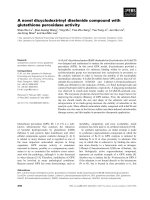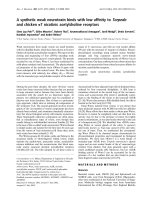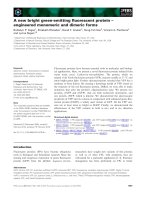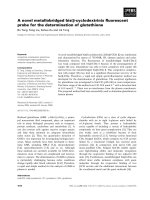Báo cáo khóa học: A new UV-B absorbing mycosporine with photo protective activity from the lichenized ascomycete Collema cristatum docx
Bạn đang xem bản rút gọn của tài liệu. Xem và tải ngay bản đầy đủ của tài liệu tại đây (197.05 KB, 5 trang )
A new UV-B absorbing mycosporine with photo protective activity
from the lichenized ascomycete
Collema cristatum
Avital Torres
1
, Malka Hochberg
4
, Inna Pergament
1
, Reem Smoum
1
, Valerie Niddam
2
,
Valery M. Dembitsky
1
, Marina Temina
5
, Inka Dor
3
, Ovadia Lev
3
, Morris Srebnik
1
and Claes D. Enk
4
1
Department of Medicinal Chemistry and Natural Products, School of Pharmacy, Hebrew University of Jerusalem, Israel;
2
Teva Pharmaceutical Industries Ltd, Petach Tikva, Israel;
3
Division of Environment Science, The Fredy and Nadine
Herrmann Graduate School of Applied Sciences, The Hebrew University of Jerusalem, Israel;
4
Department of Dermatology,
Hadassah University Hospital, Jerusalem, Israel;
5
Institute of Ecology, Haifa University, Israel
A novel photo protective mycosporine was isolated from the
lichenized ascomycete Collema cristatum. Biological activity
was measured in terms of protection against UV-B induced
membrane destruction and pyrimidine dimer formation
in cultured human keratinocytes, and prevention of UV-B
induced erythema. It was found that the pure isolated
compound prevented UV-B induced cell destruction in a
dose-dependent manner, that the compound partially pre-
vented pyrimidine dimer formation and completely preven-
ted UV-B induced erythema when applied to the skin prior
to irradiation.
Keywords: lichenized ascomycete; Collema cristatum;myco-
sporine; photo protective activity; UV-B.
Lichens are symbiotic organisms of fungi, algae and/or
cyanobacteria that synthesize numerous secondary meta-
bolites, which comprise aliphatic, aromatic, terpenoic and
halogenated compounds. Several species absorb strongly in
the UV-B range [1,2,4]. Lichens and their metabolites have
been demonstrated to possess numerous biological activit-
ies, including: antiviral, antibacterial, antitumor, antialler-
gic, antiherbivore and enzyme inhibitory activity. Some
active lichen substances are used in the pharmaceutical
industry (V. M. Dembitsky, unpublished observation, [4]).
The sun radiation reaching the earth spans from the short-
waved UV (UV-C), which is absorbed in the ozone layer,
through the UV-B (280–315 nm), the UV-A (315–400 nm)
and the visible range (400–800 nm), to the infrared. The
shorter the wavelength, the more energetic and potentially
harmful is the radiation. UV-B radiation was recognized
long ago as the cause for skin erythema (sunburn), and
accumulated exposure results in DNA damage and
immunosuppression, eventually leading to skin cancer
[5–7]. Most commercial sunscreens are designed to prevent
sunburn on the assumption that this activity will also prevent
skin cancer [8–10]. However, the dramatic increase in skin
cancer incidence rates demonstrates the inadequacy of
traditional sun protecting agents, and emphasizes the urgent
need to look for new, alternative molecules.
Such compounds may be found in certain ancient
photosynthetic organisms. As ancient plants depend on
solar irradiation as their primary source of energy, but at
the same time must provide means that can counteract the
damaging effects of UV-B irradiation on proteins, DNA
and other biologically active molecules, they have developed
various protective mechanisms that enable continuous
survival under direct and UV radiation [11–13]. In addition
to DNA repair mechanisms such as photoreactivation and
excision repair, accumulation of carotenoids, detoxifying
enzymes, radical quenchers and antioxidants, these organ-
isms can also synthesize highly effective UV absorbing
pigments such as scytonemin, mycosporine and MAAs
(mycosporine-like amino acids) [11].
Herein, we report our demonstration of the photo
protective properties of a mycosporine, isolated from the
lichenized ascomycete Collema cristatum. This mycosporine,
which we have named Collemin A, has not been described
previously.
Materials and methods
Lichen samples
The lichenized ascomycete Collema cristatum (L) F.H. Wigg.
(Jelly lichen, Collemataceae Family) was collected in January
2001 from sun exposed rock surfaces around Jerusalem
at about 700 meters above sea level. It was identified by
M. Temina (Biodiversity and Biotechnology Center of Cryp-
togamic Plants and Fungi, Institute of Evolution, University
of Haifa, Israel) and has its voucher, HAI-031511, deposited
in the Herbarium of the Institute of Evolution.
Isolation and cultivation of mycobionts
Mycobionts from Collema cristatum were obtained from the
spores discharged from the apothecia of a thallus, and were
Correspondence to M. Srebnik, Department of Medicinal Chemistry
and Natural Products, School of Pharmacy, PO Box 12065,
Hebrew University of Jerusalem, Jerusalem 91120, Israel.
Fax: + 972 2 675 8201, Tel.: + 972 2 675 7301,
E-mail:
Abbreviations: MED, minimal erythema dose; MAA, mycosporine-
like amino acid.
(Received 16 November 2003, revised 23 December 2003,
accepted 6 January 2004)
Eur. J. Biochem. 271, 780–784 (2004) Ó FEBS 2004 doi:10.1111/j.1432-1033.2004.03981.x
cultivated in test tubes containing 20.0 g malt extract
(Becton, Dickinson and Company, Franklin Lakes, NJ,
USA), 4 g yeast extract (Becton, Dickinson and Company),
100 g sucrose, 15 g agar, H
2
O, pH ¼ 7.0, at 20 °Cinthe
dark. After cultivation for three months, the colonies and
slants were harvested. Cultivation of the mycobionts isolated
from Collema cristatum andusedinourstudy,wascarried
out by I. Dor (Division of Environment Science, The Fredy
and Nadine Herrmann Graduate School of Applied Sciences,
The Hebrew University of Jerusalem, Israel).
Extraction and isolation
Extraction of the lichen body and/or cultivated mycobiont
was carried out by a mixture of methanol/water (90 : 10,
v/v), and initial column chromatography was performed
on silica gel by isocratic elution with 60% EtOH – 40%
MeOH, to yield 50 mg of a pale yellow powder. Purity of
the isolated compound was confirmed by HPLC analysis,
which showed a single sharp peak with a retention time of
14.1 min. The analysis was carried out on a reverse-phase
column RP-18 (Waters Corp.) using gradient elution with
a flow rate of 1 mLÆs
)1
ranging from 90% of 0.05% acetic
acid in water and 10% acetonitrile, to 10% of 0.05% acetic
acid in water, to 90% acetonitrile [6], and revealed a new,
highly polar, water soluble compound that absorbs strongly
in the UV-B region.
Cell cultures
A human keratinocyte cell line, HaCaT, was grown at 37 °C
in 5% CO
2
in DMEM (Biological Industries, Beit Haemek,
Israel) supplemented with 10% fetal bovine serum,
L
-glutamine 2 m
M
and antibiotics (100 U penicillin per
mL and 100 mg streptomycin per mL). Cells were grown to
80% confluence in 9 cm culture dishes, overlaid with fresh
NaCl/P
i
and placed under a UV-B light source. The cell line
originated from the laboratory of N. Fusenig, Heidelberg,
Germany. Only early passages (< 50) were used for the
experiments.
UV irradiation
UV irradiation was performed with a bank of four FS40
fluorescent lamps that emit UV-B at wavelengths between
280 and 315 nm with a peak at 313 nm. Light intensity was
determined using a Waldmann UV radiometer (Herbert
Waldmann GBH, Schwenningen, Germany). HaCaT cells
were irradiated at an irradiance of 3.4 mWÆs
)1
with a dose
of 200 mJÆcm
)2
(cell death) or 60 mJÆcm
)2
(DNA damage).
The test materials (300 lLÆ100 cm
)2
) were spread on a
quartz plate placed on the top of the Petri dish, through
which the cells were irradiated. To guarantee even distribu-
tion of the test materials, the solutions were contained inside
a rubber ring glued to the quartz plate. Keratinocytes were
harvested by trypsination either immediately (pyrimidine
dimers) or 24 h (cell survival) after irradiation. The in vivo
biological activity was assayed by the ability to prevent UV
induced erythema of human skin. After informed consent
and approval from the Ethical Committee on Experiments
on Humans (Helsinki Committee), the pure compound was
diluted 1 : 10 in olive oil and applied to the inside forearm
of a volunteer at a concentration of 6 lgÆcm
)2
. Olive oil
without the isolated compound served as control. Fifteen
minutes after application, four minimal erythema doses
(MED; 360 mJÆcm
)2
) of UV-B irradiation were delivered to
the treated areas, and the resulting erythema was evaluated
after 24 h as described previously [15].
Estimation of cell survival
Cell survival was measured 24 h after irradiation using the
trypan blue exclusion assay. Cells were harvested using
0.25% trypsin and 0.05% EDTA in PUCK’s saline
(Biological Industries, Beit-Haemek, Israel), washed with
NaCl/P
i
and counted in 0.2% trypan blue solution
(Biological Industries). Viability was calculated as the
average percent of trypan blue negative cells in five fields
of a standard hemocytometer.
Pyrimidine dimers
The DNA was extracted immediately after irradiation using
Wizard Genomic DNA Purification Kit (Promega, Madi-
son, WI, USA). Pyrimidine dimers were determined by
ELISA technique [14]. In brief, 5 lg per well of denatured
DNA was applied, in triplicates, into poly
L
-lysine (Sigma)
precoated ELISA plates, washed five times with NaCl/P
i
and blocked with 2% fetal bovine serum in NaCl/P
i
. As first
antibody, an anti-(thymidine dimer H3 clone 4F6) Ig
(Affiteck, Oslo, Norway) diluted 1 : 1000 in 2% fetal bovine
serum in NaCl/P
i
, was used. As the secondary antibody, a
biotin-SP conjugated goat anti-mouse Ig diluted 1 : 50 000
was used, followed by peroxidase conjugated strepavidin
(Jackson, West Grove, PA, USA) diluted 1 : 10 000. The
peroxidase reaction was performed using 0.4 mgÆmL
)1
o-phenylenediamine (Sigma) in the presence of 0.02%
H
2
O
2
, and color intensity was measured by spectrophoto-
metry at 492 nm.
Isolation of Collemin A
HPLC analysis was carried out on a Waters 600 instrument,
using a RP-18 column (symmetry 4.6 · 250 mm) connected
to a symmetry guard column, outfitted with Waters 996
photodiode array detector. Infrared spectra were recorded
on a Perkin-Elmer 2000 Fourier transformed infrared
instrument. High-resolution mass spectrometry analysis
was made on a Q-TOF-micro-LC mass spectrometer
(MicroMass, Manchester, UK) in Bar-Ilan University.
One dimentional and two dimentional NMR spectra were
measured on a Bruker 400 MHz spectrometer (Bruker
BioSpin Corp., MA, USA). The
1
H NMR chemical shifts
(referenced to CD
3
OD observed at 3.30 p.p.m.) were
assigned using a combination of data from correlation
spectroscopy (COSY) and heteronuclear multiple quantum
correlation (HMQC) experiments [16].
Results and discussions
Structure of Collemin A
Collemin A (Fig. 1) has a molecular formula of
C
19
H
32
N
2
O
13
(496 MW), which was determined by high-
Ó FEBS 2004 Photo protective mycosporine from Collema cristatum (Eur. J. Biochem. 271) 781
resolution fast-atom-bombardment MS (HRFABMS) in
conjunction with
1
Hand
13
C NMR data. The structure was
determined by two dimentional NMR experiments, inclu-
ding correlation spectroscopy (COSY), distortionless
enhancement by polarization transfer (DEPT), hetero-
nuclear single quantum correlation (HSQC), hetero nuclear
multiple bond correlation spectroscopy (HMBC) and
nuclear Overhauser effect spectroscopy (NOESY) as
reported by us recently [16]. Additional physical and
spectroscopic data for Collemin A is reported here for
the first time: IR (KBr Pellets): m ¼ 3382 cm
)1
(OH),
2936 cm
)1
(NH
2
), 1653 cm
)1
(CO). UV-VIS (MeOH):
k
max
(e) ¼ 311 nm (34 000
M
)1
Æcm
)1
,Fig.1);MS:
497 [MH
+
], 340 [M-C
7
O
3
NH
10
], 435 [M-O-CH
2
-CH
2
OH],
519 [M-Na]
+
. UV spectra of lichen and mycobiont have the
same absorption maximum, at 311 nm (Fig. 2). According
to this, a molar extinction coefficient (e)of34000
M
)1
Æcm
)1
was determined. The high e-value gives the isolated
compound a huge advantage over common commercial
sunscreens by having a great potential to protect from
UV-B radiation. Collemin A is a new mycosporine, which
incorporates a novel pyrrolidine ring. The UV-B absorb-
ance ability of this compound is probably of fungal origin.
Isolation of the dominant fungus (one out of four) from the
lichen, gave a UV spectrum with a similar k
max
when
compared to the lichen itself (k
max
¼ 311 nm).
Biological activity of Collemin A
To test for photo protective activity, cell survival as
estimated by the trypan blue exclusion assay was used as
a screening test. This test is simple to perform and is
essentially a measure of UV-B induced membrane destruc-
tion. As can be seen in Fig. 3, the pure compound provided
protection against UV-B damage in a dose-related manner.
DNA is the primary cutaneous target of UV radiation.
Upon exposure of DNA to wavelengths approaching its
absorbance maximum, pyrimidine dimers are formed by
covalent interaction of two adjacent pyrimidines in the same
polynucleotide chain [17]. To study the ability of the isolated
compound to prevent pyrimidine dimer formation, HaCaT
keratinocytes were irradiated through a quartz plate on
which the compound was spread, cells were harvested
immediately following irradiation and analysed for pyri-
midine dimer formation. Non-irradiated cells and cells
irradiated through a naked quartz plate served as controls.
As can be seen in Fig. 4, the number of pyrimidine dimers in
cells irradiated through the isolated compound were much
fewer than were the numbers found in irradiated nonpro-
tected cells, in fact approaching the numbers in nonirradi-
ated cultures.
The in vivo biological activity of the isolated compound
was assayed by the ability to prevent UV induced erythema
(suburn) of human skin. The pure compound was applied
to the inside forearm of a volunteer 30 min prior to four
MED of UV-B irradiation (Fig. 5). A commercial sunscreen
Fig. 1. Chemical structure of Collemin A.
Fig. 2. Comparative UV spectra of the fungus (mycobiont) and lichen
Collema cristatum. The mycobiont has a maximum at 311 nm.
Fig. 3. Effect of the pure compound isolated from Collema cristatum on
keratinocyte survival after UV-B exposure. HaCaT cells were irradiated
with UV-B (200 mJÆcm
)2
delivered at an irradiance of 3.4 mWÆs
)1
)
through a quartz plate on which the pure compound was placed. Cell
survival was estimated by trypan blue exclusion. The Collema com-
pound provided photoprotection in a dose-dependent manner.
782 A. Torres et al.(Eur. J. Biochem. 271) Ó FEBS 2004
containing octylmethoxycinnamate with a sun protecting
factor (SPF) of 12 served as control. The isolated compound
totally prevented UV-B induced erythema.
Sunburn and DNA damage are the results of excessive
UV-B exposure and are considered central events in the
initiation and promotion of skin cancer [18]. The biological
significance of such DNA lesions depends on the capacity of
the cell to repair the damage before it can be incorporated
permanently into the genome. Typically, DNA damage is
repaired at a relative high rate in human cells by various
repair mechanisms including photoreactivation, nucleotide
excision and global repair [19,20]. The ability of the isolated
compound to block pyrimidine dimer formation points to
a potential role for such compounds in the prevention of
UV-induced skin cancer.
The defence mechanisms developed by ancient photo-
synthetic organisms such as lichens, fungi, cyanobacteria,
corals and other marine organisms are much more
advanced than those of mammals because photosynthetic
organisms depend on solar irradiation as their primary
source of energy, and at the same time must provide a
mechanism that can counteract the damaging effects of
UV-B irradiation on proteins, DNA and other biologically
active molecules. These photosynthetic organisms have
developed biosynthetic pathways for the synthesis of UV
absorbing compounds that enable them to survive direct
and intense UV radiation [1,11,21]. Such compounds
include scytonemin, mycosporine and MAAs.
Scytonemin is lipid soluble and has a prominent absorp-
tion maximum in the near ultraviolet region of the UV-A
spectrum with a long tail extending into the infrared region.
The two other UV absorbing compounds contain one of
two different ring units: an aminocyclohexenone or an
aminocyclohexenimine. Mycosporines are fungal meta-
bolites with UV absorption at 310–320 nm, and can be
considered to be Schiff bases (enamino ketones), which
possess a common cyclohexenone ring system linked by an
aminoacidoranamino-alcohol[11].Incontrast,MAAsare
UV absorbing metabolites of algae that contain an amino-
cyclohexenimine ring system, with UV absorption maxima
between 310 and 360 nm. To date, 17 different amino-
cyclohexenimines and 15 aminocyclohexenones have been
identified from marine and terrestrial organisms [11].
The occurrence of high concentrations of mycosporines
and MAAs in organisms exposed to intense solar radiation
has been described to provide protection as a UV-
absorbing/screening compound [22–24]. They have been
reported to prevent three out of ten photons from hitting
cytoplasmic targets in cyanobacteria. Cells with high
concentrations of MAAs are approximately 25% more
resistant to UV radiation centered at 320 nm than those
with no or low concentrations of MAAs [25]. MAAs have
been shown to protect against UV-B induced damage of
motility and swimming velocity in a dinoflagellate Gyrod-
inium dorsum [26]. Similarly, MAAs have been reported to
protect against photo induced inhibition of photosynthesis
in another dinoflagellate, Gymnodinium sanguineum [27]. It
is evident from the present investigation that the studied
cyanobacteria are able to increase their MAA content in
response to UV-B radiation and thus may be able to adapt
to daily fluctuations in solar radiation impinging on their
natural environment. Action spectra for the induction of
Fig. 4. Prevention of UV-B induced pyrimidine dimer formation by the
Collema compound. HaCaT cells were irradiated with UV-B
(60 mJÆcm
)2
delivered at an irradiance of 3.4 mWÆs
)1
) through a
quartz plate on which the pure compound was placed at a concen-
tration of 6 lgÆcm
)2
. Nonirradiated cells and cells irradiated through a
naked quartz plate served as controls. Pyrimidine dimers were meas-
ured immediately following UV-B irradiation by the ELISA technique.
The pyrimidine dimer content is presented as percentages of the con-
tent in unprotected UV-B radiated cells.
Fig. 5. Prevention of UV-B induced erythema on human skin. The pure
compound was diluted 1 : 10 in olive oil and applied to the inside
forearmofavolunteerataconcentrationof6lgÆcm
)2
.Fifteenmin-
utes after application, four MEDs (360 mJÆcm
)2
)ofUV-Birradiation
were delivered to the treated areas and the resulting erythema was
evaluated after 24 h. A commercial octylmethoxycinnamate contain-
ing sunscreen (SPF 12) served as a control. 1, No protection (olive oil);
2, commercial sunscreen; 3, pure compound.
Ó FEBS 2004 Photo protective mycosporine from Collema cristatum (Eur. J. Biochem. 271) 783
MAAs in lichen’s cyanobacteria also support this hypo-
thesis.
In summary, we have described the structure and the
photo protective qualities of a new mycosporine, Colle-
min A, isolated from the lichenized ascomycete, Collema
cristatum.
References
1. Torres, A., Dor, I., Rotem, J., Srebnik, M. & Dembitsky, V.M.
(2003) Characterization of surface n-alkanes and fatty acids of the
epiphytic lichen Xanthoria parietina, its photobiont a green alga
Trebuxia sp. and its mycobiont, from the Jerusalem hills. Eur. J.
Biochem. 270, 2120–2125.
2. Dembitsky, V.M. (1992) Lipids of lichens. Prog. Lipid Res. 31,
373–397.
3. Reference withdrawn.
4. Muller, K. (2001) Pharmaceutically relevant metabolites from
lichens. Appl. Microbiol. Biotechnol. 56, 9–16.
5. Setlow, R.B. (2002) Shedding light on proteins, nucleic acids, cells,
humans and fish. Mutat. Res. 511, 1–14.
6. Berneburg, M. & Krutmann, J. (2000) Photoimmunology, DNA
repair and photocarcinogenesis. J. Photochem. Photobiol. B, Biol.
54, 87–93.
7. Slaper, H., Velders, G.J.M. & Matthijsen, J. (1998) Ozone
depletion and skin cancer incidence: a source risk approach.
J. Hazard. Mater. 61, 77–84.
8. Wang,R F.,Zeng,G.,Johnston,S.F.,Voo,K.&Ying,H.(2002)
Cell-mediated immune responses in melanoma: implications for
immunotherapy. Crit. Rev. Oncol. Hematol. 43, 1–11.
9. Kawada, M., Kawatsu, M., Masuda, T., Ohba, S., Amemiya, M.,
Kohama,T.,Ishizuka,M.&Takeuchi,T.(2003)Specific
inhibitors of protein phosphatase 2A inhibit tumor metastasis
through augmentation of natural killer cells. Int. Immuno-
pharmacol. 3, 179–188.
10. Das, P.K., van den Wijngaard, R.M.J.G.J., Wankowicz-Kalinska,
A. & Le Poole, I.C. (2001) A symbiotic concept of autoimmunity
and tumour immunity: lessons from vitiligo. Trends Immunol. 22,
130–136.
11. Bandaranayake, W.M. (1998) Mycosporines: are they nature’s
sunscreens? Nat. Prod. Report 15, 159–172.
12. De Nys, R. & Steinberg, P.D. (2002) Linking marine biology and
biotechnology. Curr. Opin. Biotechnol. 13, 244–248.
13. Sinha, R.P., Ambasht, N.K., Sinha, J.P., Klisch, M. & Ha
¨
der, D P.
(2003) UV-B-induced synthesis of mycosporine-like amino acids in
three strains of Nodularia (cyanobacteria). J. Photochem. Photo-
biol. B, Biol. 71, 51–58.
14. Mori,T.,Nakane,M.,Hattori,T.,Matsunagam,T.,Ihara,M.&
Nikaido, O. (1993) Simultaneous establishment of monoclonal-
antibodies specific for either cyclobutane pyrimidine dimer or
(6–4) photoproduct from the same mouse immunized with
Ultraviolet-irradiated DNA. Photochem. Photobiol. 54, 225–232.
15. Enk, D.C., Hochberg, M., Torres, A., Dembitsky, V.M. & Sreb-
nik, M. (2004) Photoprotection by Cichorium endivia extracts:
prevention of UVB induced erythema, pyrimidine dimer forma-
tion and IL-6 expression. Skin Pharmacol. Appl. Skin Physiol. 17,
42–48.
16. Enk, D.C., Hochberg, M., Torres, A., Lev, O., Dor, I., Dembit-
sky, V.M. & Srebnik, M. (2002) Natural UV Filters Derived from
Pigments of Lichens. Patent Application IL02/00725.
17. Han, M.J. & Chang, J.Y. (2000) Polynucleotide analogues. Adv.
Polymer Sci. 153, 1–36.
18. Kaina, B. (2003) DNA damage-triggered apoptosis: critical role of
DNA repair, double-strand breaks, cell proliferation and signa-
ling. Biochem. Pharmacol. 66, 1547–1554.
19. Dlugosz, A., Merlino, G. & Yuspa, S.H. (2002) Progress in
cutaneous cancer research. J. Investig. Dermatol. Symp. Proc. 7,
17–26.
20. Sancar, A. (1994) Mechanisms of DNA excision repair. Science
266, 1954–1956.
21. Budel, B., Karsten, U. & Garcia-Pichel, F. (1997) Ultraviolet-
absorbing scytonemin and mycosporine-like amino acid deriva-
tives in exposed, rock-inhabiting cyanobacterial lichens. Oecologia
112, 165–172.
22. Garcia-Pichel, F. & Castenholz, R.W. (1993) Occurrence of UV-
absorbing, mycosporine-like compounds among cyanobacterial
isolates and an estimate of their screening capacity. Appl. Environ.
Microbiol. 59, 163–169.
23. Ehling-Schulz, M. & Scherer, S. (1999) UV protection in cyano-
bacteria. Eur. J. Phycol. 34, 329–338.
24. Sinha, R.P., Klisch, M., Helbling, E.W. & Ha
¨
der, D P. (2001)
Induction of mycosporine-like amino acids (MAAs) in cyano-
bacteria by solar ultraviolet radiation. J. Photochem. Photobiol. B,
Biol. 60, 129–135.
25. Garcia-Pichel, F., Wingard, C.W. & Castenholz, R.W. (1993)
Evidence regarding the UV sunscreen role of a mycosporine-like
compound in the cyanobacterium Gloeocapsa sp. Appl. Environ.
Microbiol. 59, 170–176.
26. Klisch, M., Sinha, R.P., Richter, P.R. & Ha
¨
der, D P. (2001)
Mycosporine-like amino acids (MAAs) protect against UV-B
induced damage in Gyrodinium dorsum Kofoid. J. Plant Physiol.
158, 1449–1454.
27. Neale, P.J., Banaszak, A.T. & Jarriel, C.R. (1998) Ultraviolet
sunscreens in Gymnodinium sanguineum (Dinophyceae): mycos-
porine-like amino acids protect against inhibition of photosyn-
thesis. J. Phycol. 34, 928–938.
784 A. Torres et al.(Eur. J. Biochem. 271) Ó FEBS 2004









